KACV Kalari Academy
Kalari Payattu is one of the oldest martial arts in the world, that originated in the Indian state of Kerala.
About KACV Kalari Academy
Kalaripayattu is one of the oldest martial arts in the world, that originated in the Indian state of Kerala. Its enduring existence over centuries can be attributed to its exceptional power to bring about complete transformation in those who practice it. Kalari provides a holistic approach to well-being that encompasses an individual’s physical, mental, and spiritual aspects, while also teaching the art of peaceful coexistence.
Over time, Kalari has influenced many aspects of human activity in Kerala, including rituals, performing arts, narratives, ballads, self-defence, wars, power games, rebellion, leadership, prayers, salvation, fitness, wellness, exercise, and sports, to name just a few. Scholars debate the origins of martial arts in the Asian subcontinent, but many believe that Kalari can be considered the original source of all Asian martial arts. Kalari, created by great minds, must have attained its wholeness through interactions with multiple cultures and practices.

We firmly believe that this great tradition can contribute a lot more to the happy survival of the human race. In this light, Kerala Arts and Craft Village has decided to establish a Kalari Academy under the leadership of Padmasree Meenakshi Amma Gurukkal. The mission of the Kalari Academy is to develop multidisciplinary Kalari training that combines Kalari gurus and various modern knowledge projects within a scientific inquiry framework. Additionally, the academy aims to study the various dimensions of Kalari in collaboration with leading universities worldwide.
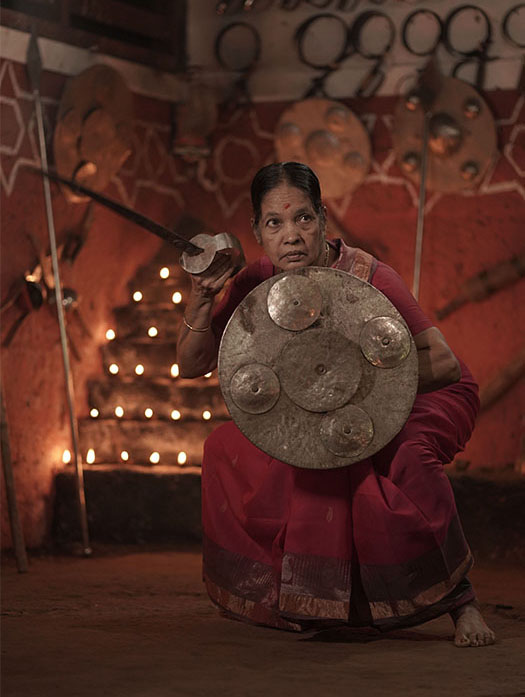
Padma Shri. Meenakshi Amma
Meenakshi Raghavan (Fondly called Amma (Mother) 80 years old – (born in 1943) is a practitioner and teacher of Kalaripayattu, the traditional martial arts form of Kerala, India. She received Padma Shri (in 2017), India’s fourth highest civilian award. She has been training in Kalari since the age of 7 and still teaching the art to others. She belongs to the Northern Kalari lineage of Kerala. Her Kalari- ‘Kadathanadan Kalari Sangam’ at the Vadakara in Kerala was built by her Guru (teacher) in 1949 whom she later married.
Inauguration Festival
Convergence of the martial & creative arts
The Kalari Academy, under the aegis of Padmasree Meenakshi Amma Gurukkal, will be inaugurated in May 2023. We are celebrating the occasion with a performance festival named ‘Aatachuvadu’ – the festival of movement arts – and a 14-day workshop for performing artists, with a special focus on Kalaripyattu and traditional methods of acting and performing arts in Kerala.


Meythari - Workshop for Performing Artists
The Meythari festival is a fortnight-long workshop for aspiring performers that highlights the culturally diverse performing arts tradition of Kerala. The workshop’s main attraction is its regular training sessions on Kalari led by Padmasree Meenakshi Amma Gurukkal, the 80-year-old Kalari Maestro. The curriculum for training is specifically designed to meet the unique requirements of the performers. Through the Kalari workshop, we expect the participants to experience a wide range of benefits, including better flexibility, enhanced mind-body coordination, sensorial attention, and teamwork abilities.
The workshop also features a session called ‘Navarasa Sadhana,’ an actor-training course that focuses on Koodiyattam techniques created by Guru G Venu and instructed by Kapila Venu. The workshop benefits from Kapila’s experience working with Japanese dancer Min Tanaka and collaboration with theatre and dance practitioners from diverse cultures. In addition, the workshop offers Kolkali training, craft demonstrations, opportunities for interactions with scholars and performers, and demonstrations of makeup, costume, and lighting related to traditional performance arts. These elements contribute to the workshop’s appeal as an exciting and comprehensive learning experience.
In addition to being attendees, the delegates to this workshop are also aficionados and coordinators of ‘Aattachuvad’ – one of the most significant festivals of the performing arts tradition of Kerala. The Kalari-centric workshop and the accompanying arts festival are mainly aimed at the concept of unity and harmony among art communities. Collaboration among artists and the cross-pollination of various art genres and artists produce a dynamic and innovative environment that fosters artistic eminence. The performance space will be meticulously designed to evoke the authentic ambience of traditional rituals. A greater immersion in the most dynamic and ancient art forms invokes one’s inner performer and rejuvenates one’s mind, body and soul. Priority will be given to aspiring female artists who wish to participate in the performance festival in order to increase female representation in the arts.
Workshop at a Glance
- Morning Kalari Sessions- Padmashri Meenakshi Amma
- Navarasa Acting Training- Kapila Venu
- Craft Making Sessions- KACV Artisans
- Demonstration Session on Performing Art-related makeup, lighting and music
- Interactions with Scholars and Performers
- Attachuvadu- A Festival of Movement Arts
Workshop Registration Closed
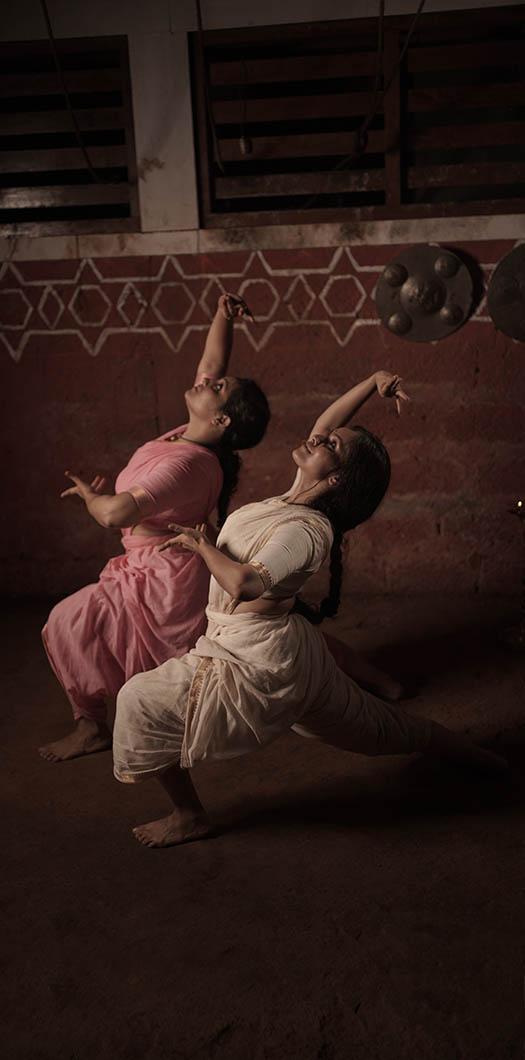
Kapila Venu
One of the key mentors at the Meythari workshop for performing artists will be Kapila Venu. She is a notable practitioner of Kutiyattam – one of the oldest living theatre traditions of the world, from Kerala, India. A disciple of the legendary Kutiyattam maestro Guru Ammannur Madhava Chakyar and renowned exponents Guru G Venu and Guru Usha Nangiar, Kapila is also an exponent of Mohiniyattam classical dance, which she studied under her mother Guru Nirmala Paniker. She has studied with renowned Japanese avant-garde dancer Min Tanaka and has performed in his choreographies. Kapila is the recipient of the highest honour for young artistes from the Govt. of India – Ustad Bismillah Khan Yuva Puraskar.
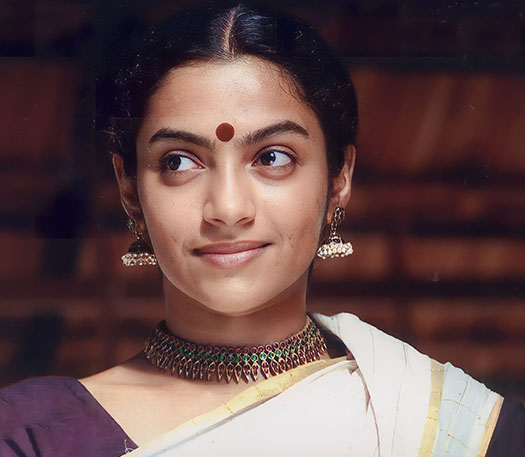
Who can apply?
- Talented performing artists.
- Performers seeking to synchronise body movements with that of the mind by training in the oldest form of martial arts.
- Those aiming to contribute to our rich cultural heritage by enriching their craft and taking it to the next level.
- Seekers of new avenues in their respective genre of art performances through exposure to Kerala’s traditional stage performances.
- Artists ready to be inspired by maestros of craft making & notable performance artists.
If you are in line with these aspirations, apply right away with your portfolio/resume.
Selection Process
This workshop will utilise a rigorous selection process to ensure the quality of its participants. If you wish to attend, please submit your resume/portfolio highlighting your achievements and knowledge in your performance art of choice. Our expert panel will review these applications and create a short list of candidates. Shortlisted candidates will have brief online interactions with the organizers to make the selection process more efficient.
Workshop Registration Closed
Attachuvadu: A Festival of Movement Arts
‘Festival of Movement Arts’ is being planned to coincide with the inauguration of the Kalari Academy. The festival is structured to explore the relationship between Kalaripayattu and the performing art tradition of Kerala. Kalaripayattu has largely impacted the development of numerous ritualistic body traditions and dance-based art forms in Kerala. The broad spectrum of postures, gestures, and movement patterns employed in performing arts are intimately linked to the performance repertoire of Kalaripayattu. The proposed festival aims to delve into the core of both the martial and performing arts traditions by revealing the historical hyperlinks between Kalaripayattu and Kerala’s performing arts traditions. This festival will feature performances that are both directly and indirectly related to Kalaripayattu in order to demonstrate the associations and linkages of the martial and performance lineage of Kerala.
The martial art of Kalaripayattu is connected to the performing arts of Kerala mainly in two ways. Kalaripayattu is inextricably linked with the performing arts of Kerala as a training system that helps in acquiring basic qualities of performance like flexibility, coordination, resilience, body posture and other skills. Additionally, some performances use the body movements of Kalaripayattu as the narrative of the battle scenes. For instance, Kalari training and massaging are employed to enhance performers’ flexibility in performance such as Kathakali, Koodiyattam and Padayani. In contrast to the application of Kalari as a training method in performances, certain other performances such as Theyyam and Velakali display Kalaripayattu skills to demonstrate the performance of warrior narratives. In Kalaripayattu, the most important skill remains to achieve certain poses known as ‘chuvadukal,’ or the position of the entire body that gives strength to perform a particular movement or task. Chuvadu became a standard component of performances because body movements are equally incorporated into Kalari and other performing arts of Kerala.

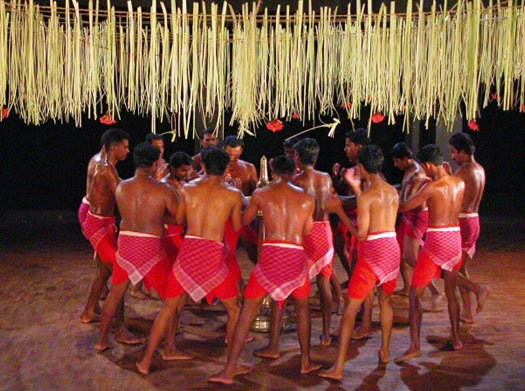
Day 1: Poorakkali

Day 2: Parichamuttukali
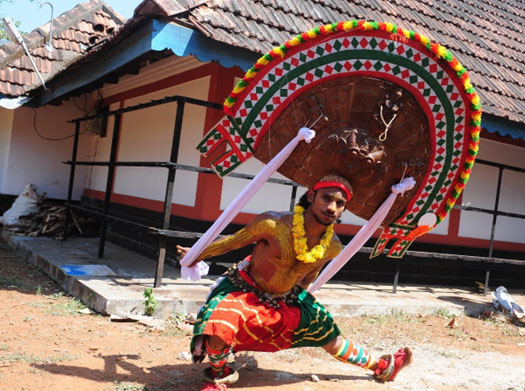
Day 3: Poothanum Thirayum
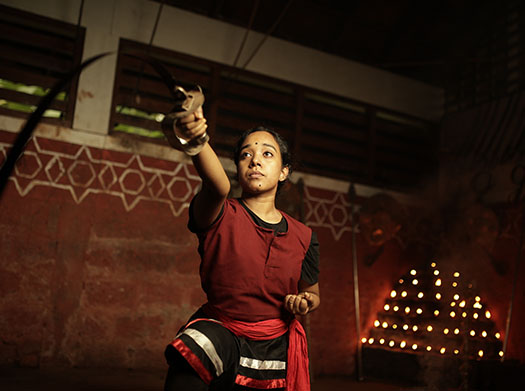
Day 4: Contemporary performance
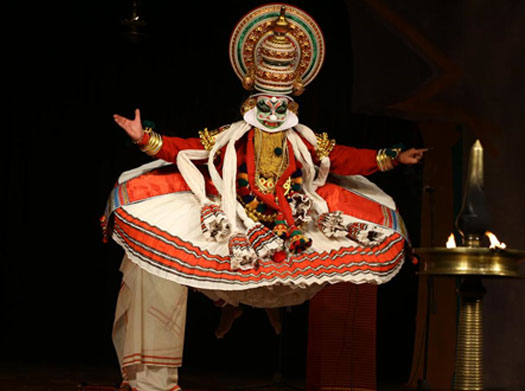
Day 5: Kathakali
Kathakali is a classical dance-drama form that originated in Kerala, a southern state in India. It is a highly stylized and elaborate art form that combines dance, music, and acting to tell stories from Hindu mythology. The name Kathakali is derived from two Malayalam words, “katha” meaning story and “kali” meaning performance or play. The training and performance of Kathakali is steeped in tradition and ritual. The performers undergo years of rigorous training in order to master the various aspects of the form, including the physical movements, facial expressions, and vocal techniques.
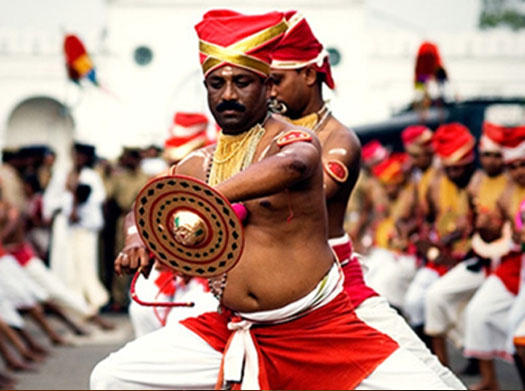
Day 6: Velakali
Velakali is a stylised martial art performance which blends movements and postures of Kathakali and kalarippayattu. To the music of an orchestra made up of the maddalam, ilathalam, kombu, and kuzhal, the dancers perform martial art choreography and skilful sword play while wearing the customary outfits and bright headgear of the mediaeval Nair soldiers. Velakali was first performed in Ambalappuzha, where it was encouraged by Mathoor Panicker, the commander of the Chempakasserri army, to instil a sense of chivalry in the people of the region. The dance form is a regular feature of the annual festivities at the Ambalappuzha Sree Krishna temple in Alappuzha district.
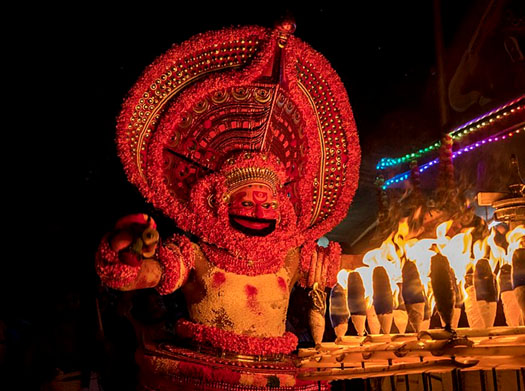
Day 7: Theyyam
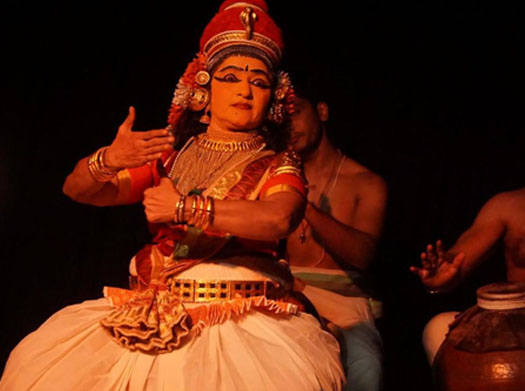
Day 8: Nangiyar Kuthu
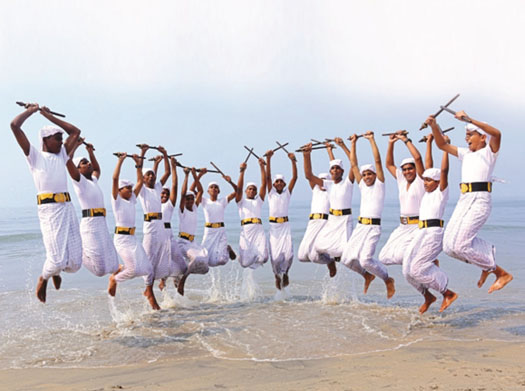
Day 9: Kolkali

Day 10: Nayadi Kali
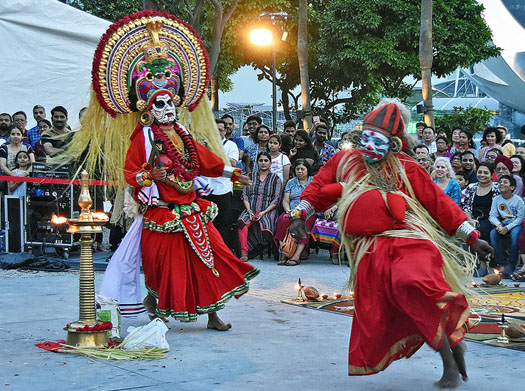
Day 11: Mudiyettu
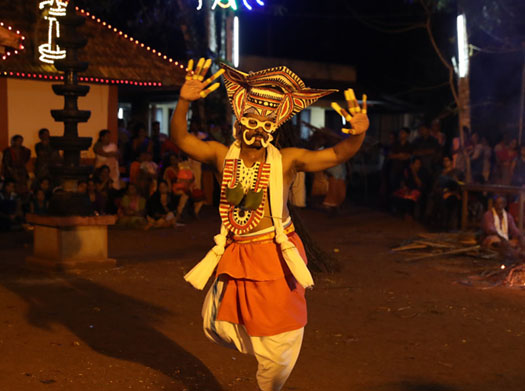
Day 12:Padayani
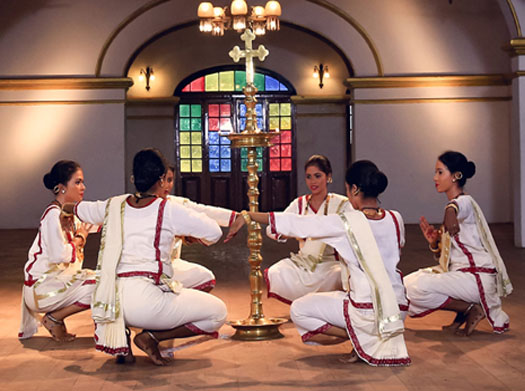
Day 13: Margamkali

